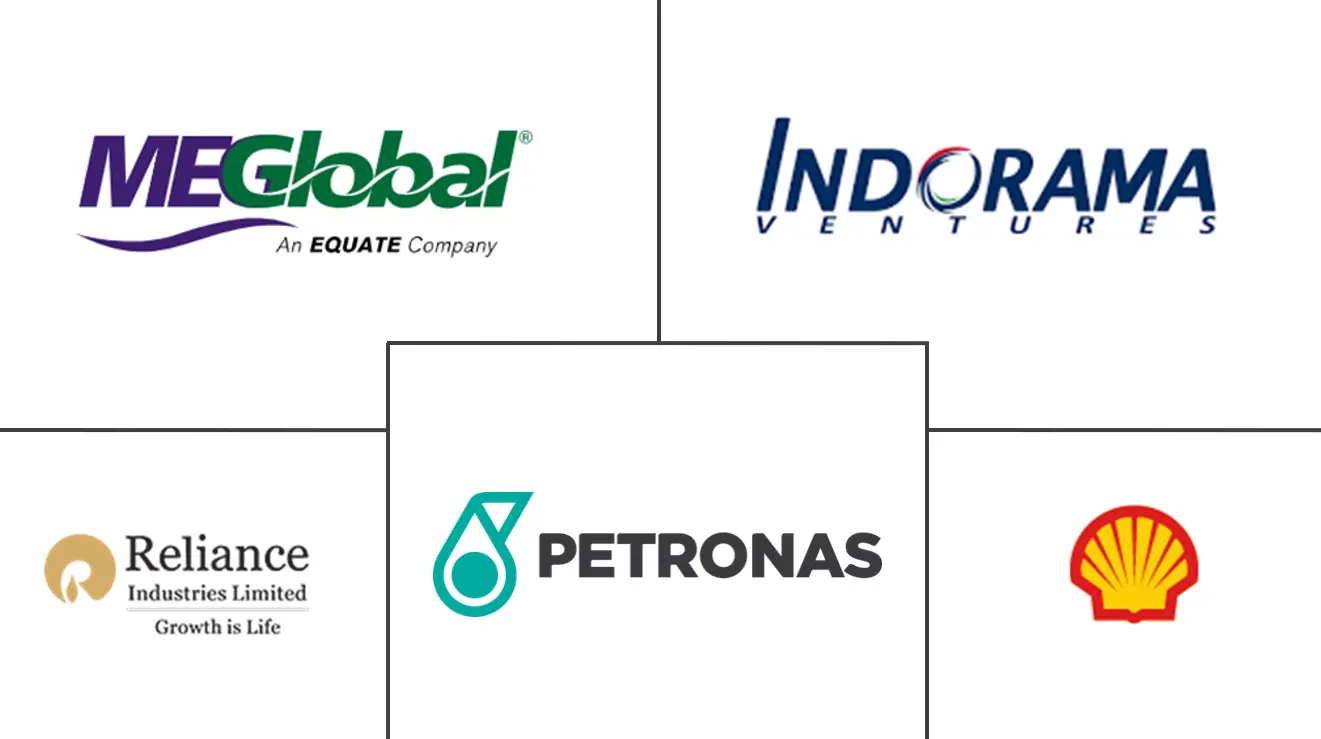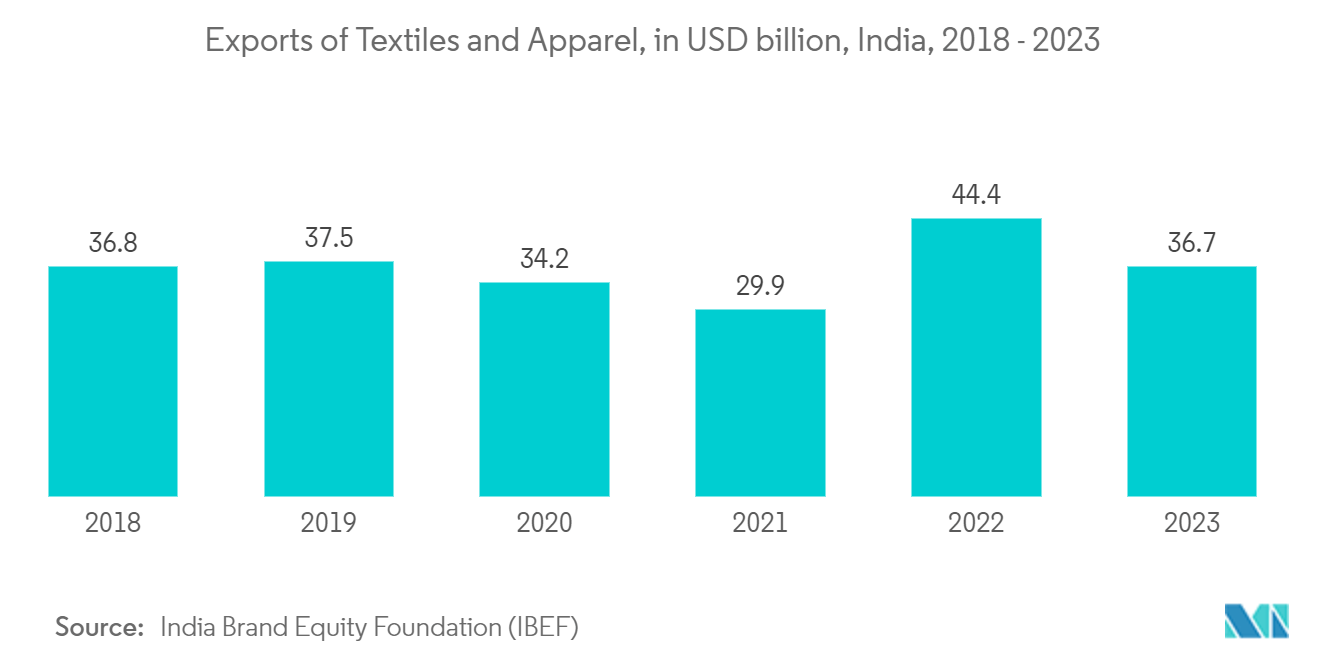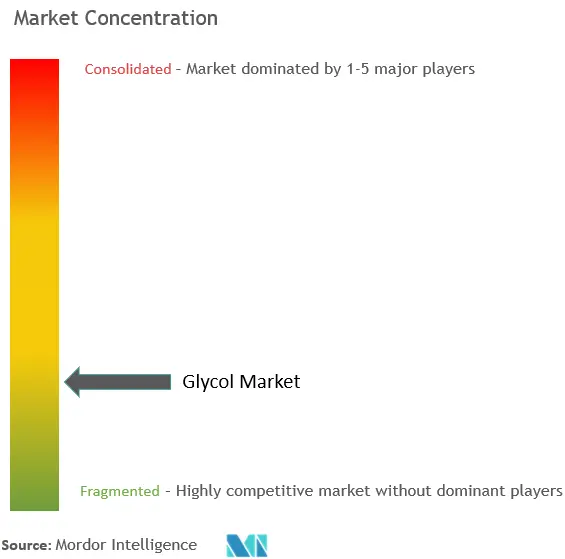Glycol Market Size

| Study Period | 2019 - 2029 |
| Market Volume (2024) | 46.10 Million tons |
| Market Volume (2029) | 60.82 Million tons |
| CAGR (2024 - 2029) | 5.70 % |
| Fastest Growing Market | Asia Pacific |
| Largest Market | Asia Pacific |
| Market Concentration | Low |
Major Players
*Disclaimer: Major Players sorted in no particular order |
Glycol Market Analysis
The Glycol Market size is estimated at 46.10 Million tons in 2024, and is expected to reach 60.82 Million tons by 2029, growing at a CAGR of 5.70% during the forecast period (2024-2029).
In 2020, the COVID-19 pandemic triggered nationwide lockdowns and social distancing measures, disrupting supply chains and shuttering numerous manufacturing sectors. This adversely affected the glycol market. However, the market recovered in 2021, and it is expected to grow steadily during the forecast period.
- Over the short term, increasing usage in the textile industry and growing demand from the food and beverage sector are the major factors driving the demand for the market studied.
- However, toxicity and environmental concerns are expected to hinder the market's growth.
- Nevertheless, increasing demand for bio-based glycols is expected to create new opportunities for the market studied.
- Asia-Pacific is expected to dominate the global market, with the majority of demand coming from China, India, and Japan.
Glycol Market Trends
Increasing Usage in the Textile Industry
- Key raw materials propylene glycol and ethylene glycol are pivotal in producing various products, most notably polyester fibers. These fibers find applications in clothing, upholstery, carpets, and pillows.
- Ethylene glycol's most prominent application is in polyester fibers, which dominate the textile industry. Additionally, glycol ethers play a crucial role as dyebath additives in the textile market, enhancing properties like shade accuracy, level dyeing, colorfastness, and reducing dyeing temperatures and cycle times.
- With the global textile sector on the rise, the demand for glycols is set to increase. Data from the World Trade Statistical Review 2023 and UN Comtrade highlighted that in 2022, China, the European Union, and India were the top three textile exporters, collectively accounting for 72.1% of global textile exports.
- China leads the world in both spandex production and consumption. The Spandex Branch of China Chemical Fibers Association reported that by the end of 2023, China's spandex capacity reached 1.2395 million tons/year. After adjustments, this marked a net capacity increase of 143 kt/year, translating to a 13% growth from 2022.
- India's textile sector, one of the nation's oldest industries, impacts the economy significantly, accounting for 2.3% of the GDP, 13% of industrial production, and 12% of exports. Data from the Indian Brand Equity Foundation showed that the total textile and apparel exports reached USD 36.7 billion in 2023. It is estimated to reach USD 35.9 billion in 2024. Additionally, exports of readymade garments and accessories were valued at USD 14.23 billion. In FY 2024, exports of textiles and apparel to the United States, India's largest market, constituted 32.7% of the total export value. This surge in exports is expected to bolster the demand for glycols in India.
- According to data from the National Council of Textile Organization (NCTO), the United States ranks as the world's third-largest textile exporter. The US textile industry supplies over 8,000 products to the military and achieved shipments worth USD 64.8 billion in 2023. The country stands out as a global leader in textile research and development.
- Renowned for its prestigious fashion brands, Italy is witnessing a transformation in its textile sector, striving for modernization while embracing technological advancements. ITMA reports that Italy boasts around 45,000 textile and fashion companies.
- Data from Comex Stat (Brazil) revealed that in 2023, Argentina was the primary destination for Brazilian textile and apparel exports, valued at over USD 230 million. Paraguay and Uruguay followed, with exports worth USD 133 million and USD 78 million, respectively.
- In Africa, South Africa emerged as the continent's leading textile exporter, with exports reaching USD 3.8 billion in 2023. A significant portion of these exports, primarily technical textiles, catered to aeronautics companies, as reported by the data from the Apparel and Textile Association of South Africa.
- Given these dynamics, the global glycol market is poised for growth in the coming years.

Asia-Pacific to Dominate the Market
- Asia-Pacific is poised to lead glycol consumption, dominating the market and emerging as the fastest-growing region during the forecast period. This surge is fueled by escalating demands from diverse end-user industries, including packaging, food and beverage, automotive, transportation, cosmetics, and textiles, particularly in nations like China, India, South Korea, Japan, and various Southeast Asian countries.
- In Asia-Pacific, industries such as food and beverage and consumer goods are increasingly seeking packing materials, driven by rising exports and domestic consumption. The region's packaging market is buoyed by a growing appetite for packaged foods and fast-moving consumer goods, especially with the rise of e-commerce. Due to their advantages, engineering plastic products, notably PET containers and bottles, are witnessing a significant uptick in the packaging sector. PET is derived from ethylene glycol, dimethyl terephthalate (DMT), or terephthalic acid.
- China’s packaging industry is one of the significant global packaging industries. The consistent growth of China's packaging industry can be attributed to its expanding economy and a burgeoning middle class with increased purchasing power. Furthermore, the packaging industry in the country is expected to grow. A report by the Chinese government estimates the industry achieving a valuation of CNY 2 trillion (USD 290 billion) by 2025.
- With the rising food processing industry, India anticipates heightened demand for food packaging. The Ministry of Food Processing highlights that the food processing sector, a major player in India's economy, represents 32% of the overall food market. Projections estimate the industry's output to hit USD 535 billion by 2025, growing at an annual rate of 15.2%, supporting the market's growth.
- Beyond packaging, ethylene glycol plays a crucial role as an anti-freezing agent in car radiators. The automotive landscape is vibrant, with China leading globally. Data from the Organisation Internationale des Constructeurs d'Automobiles (OICA) revealed that in 2023, China produced 30.16 million vehicles, a 12% increase from 27.02 million in 2022. This surge in automobile production is poised to bolster the glycol market.
- South Korea boasts a mature automotive industry with notable brands like Hyundai, Renault, Samsung, and Kia. Projections from the Automobile Manufacturers Association and Korea Automobile Research Institute anticipate a 1.0% rise in domestic automobile production for 2024, reaching 4.36 million units. This growth is expected to drive demand in the market studied.
- China's cosmetics landscape has seen rapid growth over the past decade. Data from the National Bureau of Statistics of China indicated that in 2023, retail sales of cosmetics reached approximately CNY 414.17 billion (~USD 58.5 billion). With demand surging in second and third-tier cities and a notable rise in men's skincare, the glycol market is set to thrive.
- South Korea ranks among the top ten global beauty markets and is celebrated for its innovation, use of natural ingredients, and attractive packaging. According to the data from the Ministry of Food and Drug Safety (MFDS), Korea's cosmetics exports hit USD 8.5 billion in 2023, securing fourth position globally.
- India's pharmaceutical sector, known for its affordable and high-quality medicines, is on a trajectory of rapid scientific advancements. The government forecasts the industry's value to soar from USD 50 billion to USD 130 billion by 2030 and an ambitious USD 450 billion by 2047. Such growth signals a heightened demand for glycol in pharmaceutical drug production during the forecast period.
- Given these dynamics, Asia-Pacific is set for significant growth, driven by surging demands across various industries.

Glycol Industry Overview
The glycol market is fragmented in nature. The major players include Shell PLC, MEGlobal, Indorama Ventures Public Company Limited, Reliance Industries Limited, and PETRONAS Chemicals Group Berhad.
Glycol Market Leaders
-
Shell PLC
-
Indorama Ventures Public Company Limited
-
Reliance Industries Limited
-
MEGlobal
-
PETRONAS Chemicals Group Berhad
*Disclaimer: Major Players sorted in no particular order

Glycol Market News
- May 2024: Dow commenced an expansion of its propylene glycol (PG) capacity at its integrated manufacturing facility in Map Ta Phut, Rayong, Thailand. This expansion boosts the facility's PG output by 80,000 tons annually, elevating the total production to 250,000 tons annually. This strategic move optimizes Dow's existing asset infrastructure at the Map Ta Phut site. It also solidifies its regional and global leadership position in the industry, enabling the company to serve its customers more effectively.
- March 2024: Dow introduced two new sustainable propylene glycol (PG) solutions in North America, utilizing bio-circular (REN) and circular feedstocks (CIR). The newly launched PG solutions, CIR and REN, aim to assist customers in achieving their circular and sustainability objectives. These solutions serve a wide range of applications spanning various industries, such as personal care, cosmetics, pharmaceuticals, food ingredients, flavorings, fragrances, agriculture, and industrial sectors.
Glycol Market Report - Table of Contents
1. Introduction
1.1 Study Assumptions and Market Definition
1.2 Scope of the Study
2. Research Methodology
3. Executive Summary
4. Market Dynamics
4.1 Drivers
4.1.1 Increasing Usage in the Textile Industry
4.1.2 Growing Demand from the Food and Beverage Sector
4.1.3 Other Drivers
4.2 Restraints
4.2.1 Toxicity and Environmental Concerns
4.2.2 Other Restraints
4.3 Industry Value Chain Analysis
4.4 Porter's Five Forces Analysis
4.4.1 Bargaining Power of Suppliers
4.4.2 Bargaining power of Buyers
4.4.3 Threat of New Entrants
4.4.4 Threat of Substitute Products and Services
4.4.5 Degree of Competition
5. Market Segmentation (Market Size in Volume)
5.1 By Type
5.1.1 Ethylene Glycol
5.1.1.1 Monoethylene Glycol (MEG)
5.1.1.2 Diethylene Glycol (DEG)
5.1.1.3 Triethylene Glycol (TEG)
5.1.1.4 Polyethylene Glycol (PEG)
5.1.2 Propylene Glycol
5.1.3 Other Types
5.2 By End-user Industry
5.2.1 Automotive and Transportation
5.2.2 Packaging
5.2.3 Food and Beverage
5.2.4 Cosmetics
5.2.5 Pharmaceuticals
5.2.6 Textile
5.2.7 Other End-user Industries
5.3 By Geography
5.3.1 Asia-Pacific
5.3.1.1 China
5.3.1.2 India
5.3.1.3 Japan
5.3.1.4 South Korea
5.3.1.5 Malaysia
5.3.1.6 Thailand
5.3.1.7 Indonesia
5.3.1.8 Vietnam
5.3.1.9 Rest of Asia-Pacific
5.3.2 North America
5.3.2.1 United States
5.3.2.2 Canada
5.3.2.3 Mexico
5.3.3 Europe
5.3.3.1 Germany
5.3.3.2 United Kingdom
5.3.3.3 France
5.3.3.4 Italy
5.3.3.5 Spain
5.3.3.6 NORDIC Countries
5.3.3.7 Turkey
5.3.3.8 Russia
5.3.3.9 Rest of Europe
5.3.4 South America
5.3.4.1 Brazil
5.3.4.2 Argentina
5.3.4.3 Colombia
5.3.4.4 Rest of South America
5.3.5 Middle East and Africa
5.3.5.1 Saudi Arabia
5.3.5.2 Qatar
5.3.5.3 United Arab Emirates
5.3.5.4 Nigeria
5.3.5.5 Egypt
5.3.5.6 South Africa
5.3.5.7 Rest of Middle East and Africa
6. Competitive Landscape
6.1 Mergers and Acquisitions, Joint Ventures, Collaborations, and Agreements
6.2 Market Share(%)**/Ranking Analysis
6.3 Strategies Adopted by Leading Players
6.4 Company Profiles
6.4.1 BASF SE
6.4.2 China Petrochemical Corporation
6.4.3 China Sanjiang Fine Chemical Co. Ltd
6.4.4 Dow
6.4.5 Huntsman International LLC
6.4.6 India Glycols Limited
6.4.7 Indian Oil Corporation Ltd
6.4.8 Indorama Ventures Public Company Limited
6.4.9 INEOS
6.4.10 LOTTE Chemical Corporation
6.4.11 LyondellBasell Industries Holdings B.V.
6.4.12 MEGlobal
6.4.13 Mitsubishi Chemical Group Corporation
6.4.14 Nouryon
6.4.15 PETRONAS Chemicals Group Berhad
6.4.16 Petrorabigh
6.4.17 Reliance Industries Limited
6.4.18 SABIC
6.4.19 Shell PLC
- *List Not Exhaustive
7. Market Opportunities and Future Trends
7.1 Increasing Demand for Bio-based Glycols
7.2 Other Opportunities
Glycol Industry Segmentation
Glycol, a member of the alcohol family, consists of chemical compounds characterized by two hydroxyl (OH) groups attached to separate carbon atoms. The term "glycol" often refers to its simplest form, ethylene glycol. This compound is a colorless, odorless, and flammable liquid with a sweet taste and viscous texture. While it finds extensive applications across diverse sectors, ranging from automotive and packaging to pharmaceuticals, food and beverage processing, textiles, etc., it is essential to note that high concentrations can be toxic to humans.
The glycol market is segmented by type, end-user industry, and geography. By type, the market is segmented into ethylene glycol (monoethylene glycol (MEG), diethylene glycol (DEG), triethylene glycol (TEG), and polyethylene glycol (PEG)), propylene glycol, and other types. By end-user industry, the market is segmented into automotive and transportation, packaging, food and beverage, cosmetics, pharmaceuticals, textiles, and other end-user industries. The report also covers the market sizes and forecasts for the global glycol market in 27 countries across major regions. For each segment, the market sizing and forecasts are based on volume in tons.
| By Type | ||||||
| ||||||
| Propylene Glycol | ||||||
| Other Types |
| By End-user Industry | |
| Automotive and Transportation | |
| Packaging | |
| Food and Beverage | |
| Cosmetics | |
| Pharmaceuticals | |
| Textile | |
| Other End-user Industries |
| By Geography | |||||||||||
| |||||||||||
| |||||||||||
| |||||||||||
| |||||||||||
|
Glycol Market Research FAQs
How big is the Glycol Market?
The Glycol Market size is expected to reach 46.10 million tons in 2024 and grow at a CAGR of 5.70% to reach 60.82 million tons by 2029.
What is the current Glycol Market size?
In 2024, the Glycol Market size is expected to reach 46.10 million tons.
Who are the key players in Glycol Market?
Shell PLC, Indorama Ventures Public Company Limited, Reliance Industries Limited, MEGlobal and PETRONAS Chemicals Group Berhad are the major companies operating in the Glycol Market.
Which is the fastest growing region in Glycol Market?
Asia Pacific is estimated to grow at the highest CAGR over the forecast period (2024-2029).
Which region has the biggest share in Glycol Market?
In 2024, the Asia Pacific accounts for the largest market share in Glycol Market.
What years does this Glycol Market cover, and what was the market size in 2023?
In 2023, the Glycol Market size was estimated at 43.47 million tons. The report covers the Glycol Market historical market size for years: 2019, 2020, 2021, 2022 and 2023. The report also forecasts the Glycol Market size for years: 2024, 2025, 2026, 2027, 2028 and 2029.
Glycol Industry Report
The Glycol Market report provides a comprehensive industry analysis, covering various types of glycol such as ethylene glycol (including Monoethylene Glycol, Diethylene Glycol, Triethylene Glycol, and Polyethylene Glycol), propylene glycol, and other types. The report delves into the market segmentation by end-user industries, which include automotive and transportation, packaging, food and beverage, cosmetics, pharmaceuticals, textile, and other end-user industries. The analysis spans across different geographical regions, including Asia-Pacific, North America, Europe, South America, and the Middle-East and Africa.
The industry outlook indicates a positive market growth, supported by detailed industry statistics and trends. The market forecast provides insights into future market growth and value, helping stakeholders understand the market size and segmentation. The report also includes industry research and market data, offering an in-depth market overview and review.
Key industry reports and market reports are available as a sample in a report PDF, which includes a market cap and price trends analysis. The market outlook and predictions highlight the potential growth rate and market leaders, providing valuable industry information and research companies' insights.
Overall, this report example serves as a vital resource for understanding the glycol market, offering a detailed industry analysis, market forecast, and industry trends. The report covers all necessary aspects, from market segmentation and value to industry sales and growth rate, making it an essential tool for market research and strategic planning.



